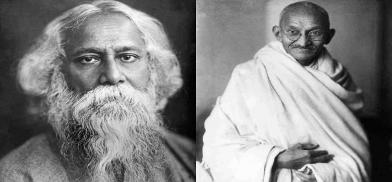Tagore and Gandhi's ideas have great relevance in today's world
Today the distance between the vision and way of life of Tagore and Gandhi and current perspectives is growing. And though the effort and work done with fervour in their names continue, most of that energy is outside India.

Last month, Indian External Affairs Minister S Jaishankar unveiled a statue of Rabindranath Tagore at the International Friendship Park in Vietnam’s Bac Ninh province. Vietnam has cherished its link with Tagore and has been rekindling his three-day visit to Ho Chi Minh City in 1929 in many ways. It includes a translation of his “Gitanjali” - which is “Loi Dang” in Vietnamese - and a commemorative postage stamp in the 80s in Tagore’s honour. At the same time in Santiniketan, West Bengal, the spiritual centre Tagore founded and the Viswa Bharati University within it, have been celebrating the UNESCO world heritage status accorded in September. Plaques installed in the Visva-Bharati University to mark being declared a World Heritage Site carried the names of the chancellor of the university, Prime Minister Narendra Modi and the vice chancellor: Bidyut Chakraborty (who retired last month), but make no mention of the founder and first Asian Nobel laureate Rabindranath Tagore.
In response, the university has clarified that the plaques are “temporary structures” which would be replaced. But this doesn’t sit well as it comes at a time when Viswa Bharati is in the midst of another controversy as it tries to evict Nobel laureate Amartya Sen from his ancestral abode in Santiniketan. A letter signed by the deputy registrar of the university said that Amartya Sen’s house had been built on land belonging to the university. "It has been found from records and physical survey/demarcation that you are in unauthorised occupation of 13 decimals of land belonging to Visva Bharati..." A decimal is 435.6 sq feet. His father Asutosh Sen had taken 125 decimals of land on lease from the varsity in 1943, Nobel laureate Amartya Sen said after the university served him a notice in April,
West Bengal Chief Minister Mamata Banerjee has alleged that Amartya Sen is being harassed for his criticism of the BJP’s policies. Whether that is the case or not, the controversy subdued Tagore‘s 162nd birth anniversary commemorations in May and the celebration of Santiniketan, with its historic buildings, landscapes, gardens, pavilions, educational and cultural traditions, being declared a UNESCO World Heritage Site. It is the 41st Indian site after Dholavira, the Harappan city in Kutch, Gujarat.
Erasing history
There is no doubt that such a lapse can be easily corrected. But the controversy itself points to a growing tendency to criticise, disregard or ignore people, voices, ideas, ideologies and perspectives that don’t fit in with current ideological thinking. A bit of history missing, a founder’s name is left out on a commemorative pillar or plaque, names and eras left out of textbooks are not uncommon now.
Earlier this year, the National Council of Educational Research and Training (NCERT) announced its decision to remove certain parts related to the Mughal period from the Class 12 history syllabus. The move which attracted much criticism was attributed to "syllabus rationalisation" where "overlapping" and "irrelevant" portions were dropped.
While some of these instances may be attributed to haste or oversight, most of them seem to be cases of selective amnesia when it comes to people, ideas and reasoning that do not fit in with current thinking and mindsets. This seems particularly so with Gurudev Tagore and Mahatma Gandhi whose thoughts, ideas and way of living are a contrast with the mores of today. For one, Viswa Bharati represents the thinking of Tagore. Founded in December 1921 and declared a central university and institution of national importance by an Act of Parliament 1951, it is a residential school and centre for the arts based on ancient Indian traditions, distinct from and repudiating the British colonial educational system that was prevalent then. Instead, it looked more to an Asian modernity while drawing on ancient, medieval and folk traditions from across the region.
Distance growing
Both Tagore and Gandhi were keen on education with a distinct indigenous identity based on the cultural experience of India and were inspired by learning that was in harmony with nature. In keeping with this Tagore had in 1901 started with a kind of ashram school where children could play and learn in the open and under the shade of trees away from the closed confines of classrooms. His father Debendranath Tagore had bought the land in 1863, built an ashram and lived there in accordance with spiritual values. Rabindranath Tagore settled here later to follow his literary pursuits.
Today, the distance between the vision and way of life of Tagore and Gandhi and current perspectives is growing. And though the effort and work done with fervour in their names continue, most of that energy is outside India. For instance, professors teaching the International Course on Gandhian Nonviolence: Theory and Application, offered by Gujarat Vidyapith, Ahmedabad, founded by Mahatma Gandhi in 1920, have found that the course has drawn students from countries in Europe, North, Central and South America, Australia, Africa and Asia. Similarly attended have been the short-term training programmes organised by the Satyagraha Institute based in Brookings, S. Dakota, in Mexico and African countries like Nigeria, Ghana, Gambia, Senegal etc. A number of participants were and continue to be drawn from conflict zones and share a common angst about the growing violence in their own societies and felt it was their duty to address this problem. Deeply impacted by the courses and training, most of them are now working with NGOs or have established their own organisations. True to the Gandhian tradition they focus on constructive work, resistance against injustice and elimination of violence in all forms.
Tagore’s vision and ideas may be losing appeal in the new framework in India, but outside candles are still being lit for India’s most famous poet laureate. The Tagore Memorial Grove and Walking Museum, one of the first in the United States to spread the message of Tagore's borderless world, was inaugurated this February at Ray Miller Park in Houston, Texas. The energised crowd, mostly diaspora, Vedic chants, recitation of Tagore's musical compositions, offers hope that his memory and what he stood for lives on at a time when borders are being reinforced and major conflicts are in progress. This may be a good time to bring Tagore and Gandhi back on the plaques and back in our lives.
(The writer is the Managing Editor of The Billion Press. Views are personal. By special arrangement with The Billion Press)










Post a Comment